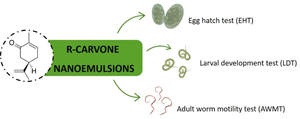Article contents
In vitro anthelmintic activity of an R-carvone nanoemulsions towards multiresistant Haemonchus contortus
Published online by Cambridge University Press: 02 September 2022
Abstract

This work aimed to evaluate the in vitro anthelmintic effect of carvone nanoemulsions on Haemonchus contortus. Three R-carvone nanoemulsions were prepared: uncoated R-carvone nanoemulsions homogenized in a sonicator (UNAlg-son) and homogenized in an ultrahomogenizer (UNAlg-ultra) and sodium alginate-coated R-carvone (CNAlg-ultra). The physicochemical characterizations of the nanoemulsions were carried out. The anthelmintic activity was evaluated using egg hatch test (EHT), larval development test (LDT) and adult worm motility test (AWMT). Changes in cuticle induced in adult H. contortus were evaluated by scanning electron microscopy (SEM). The results were subjected to analysis of variance and compared using the Tukey test (P < 0.05). The effective concentration to inhibit 50% (EC50) of egg hatching and larval development was calculated. The particle sizes were 281.1 nm (UNAlg-son), 152.7 nm (UNAlg-ultra) and 557.8 nm (CNAlg-ultra), and the zeta potentials were −15 mV (UNAlg-son), −10.8 mV (UNAlg-ultra) and −24.2 mV (CNAlg-ultra). The encapsulation efficiency was 99.84 ± 0.01%. SEM of the nanoemulsions showed an increase in size. In EHT, the EC50 values of UNAlg-son, UNAlg-ultra and CNAlg-ultra were 0.19, 0.02 and 0.17 mg mL−1, respectively. In LDT, they were 0.29, 0.31 and 0.95 mg mL−1 for UNAlg-son, UNAlg-ultra and CNAlg-ultra, respectively. The adult motility inhibition was 100% after 12 h of exposure to UNAlg-ultra and CNAlg-ultra, while for UNAlg-son, it was 79.16%. SEM showed changes in the buccal capsule and cuticular damage. It was concluded that R-carvone nanoemulsions showed antiparasitic action demonstrating promise for the control of infections caused by gastrointestinal nematodes in small ruminants.
- Type
- Research Article
- Information
- Copyright
- Copyright © The Author(s), 2022. Published by Cambridge University Press
References
- 4
- Cited by





